belt OLDSMOBILE BRAVADA 1996 Owner's Manual
[x] Cancel search | Manufacturer: OLDSMOBILE, Model Year: 1996, Model line: BRAVADA, Model: OLDSMOBILE BRAVADA 1996Pages: 340, PDF Size: 17.49 MB
Page 32 of 340
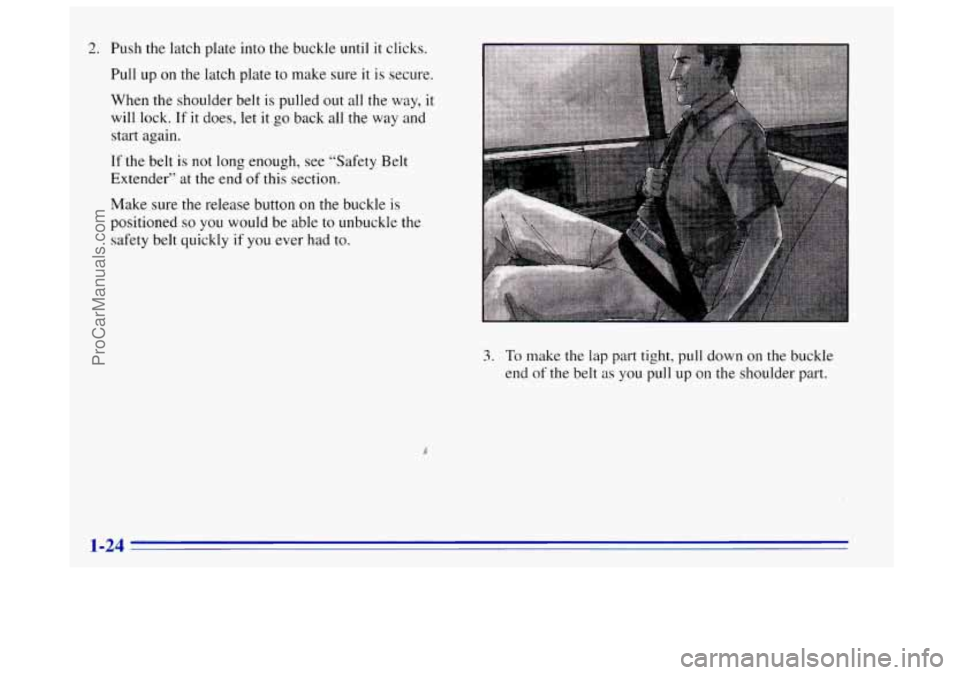
2. Push the latch plate into the buckle until it clicks.
Pull up on the latch plate to make sure
it is secure.
When the shoulder belt is pulled out all the way, it
will lock.
If it does, let it go back all the way and
start again.
If the belt is not long enough, see “Safety Belt
Extender” at the end
of this section.
Make sure the release button
on the buckle is
positioned so you would be able to unbuckle the
safety belt quickly if you ever had to.
3. To make the lap part tight, pull down on the buckle
end of the belt as you pull up on the shoulder part.
1-24
ProCarManuals.com
Page 33 of 340

n n
I i
The lap part of the belt should be worn low and snug on
the hips, just touching the thighs. In a crash, this applies
force to the strong pelvic bones. And you’d be less likely
to slide under the lap belt. If you slid under it, the belt
would apply force at your abdomen. This could cause
serious or even fatal injuries. The shoulder belt should
go
over the shoulder and across the chest. These parts of the
body are best able to take belt restraining forces.
The safety belt locks if there’s a sudden stop
or a crash.
The safety belt also locks if you pull the belt very
quickly out of the retractor.
.A CAUTION:
I
You can be seriously hurt if your shoulder belt is
too loose.
In a crash, you would move forward
too much, which could increase injury. The
shoulder belt should
fit against your body.
ProCarManuals.com
Page 34 of 340
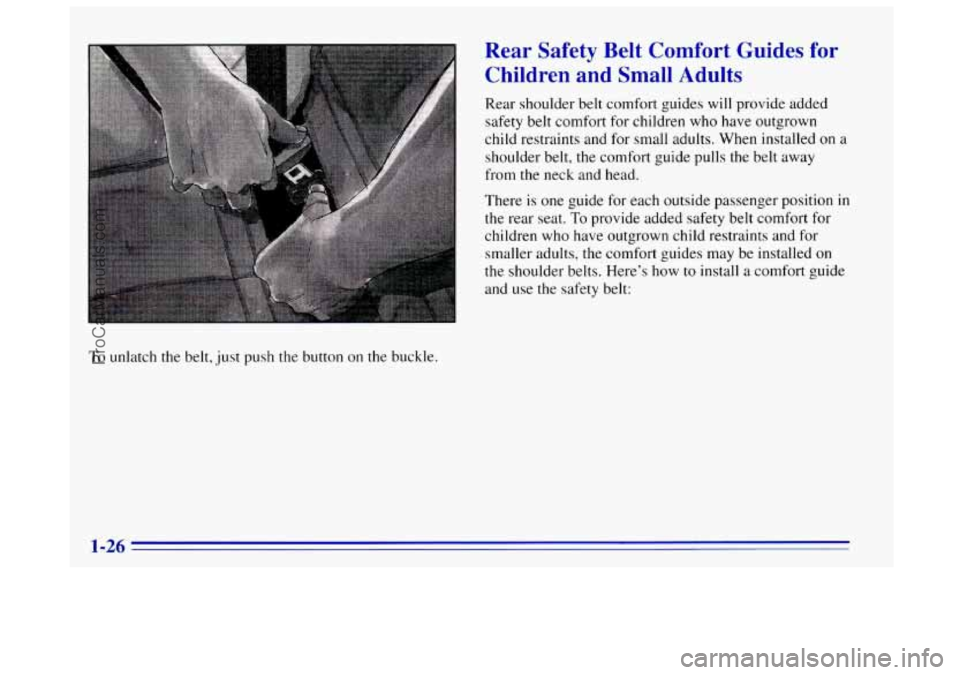
~~~ ~ To unlatch the belt,
just push the button on the buckle.
Rear Safety Belt Comfort Guides for
Children and Small Adults
Rear shoulder belt comfort guides will provide added
safety belt comfort for children who have outgrown
child restraints and for small adults. When installed on
a
shoulder belt, the comfort guide pulls the belt away
from the neck and head.
There is one guide for each outside passenger position
in
the rear seat. To provide added safety belt comfort for
children who have outgrown child restraints and for smaller adults, the comfort guides may be installed on
the shoulder belts. Here’s how
to install a comfort guide
and use the safety belt:
ProCarManuals.com
Page 35 of 340
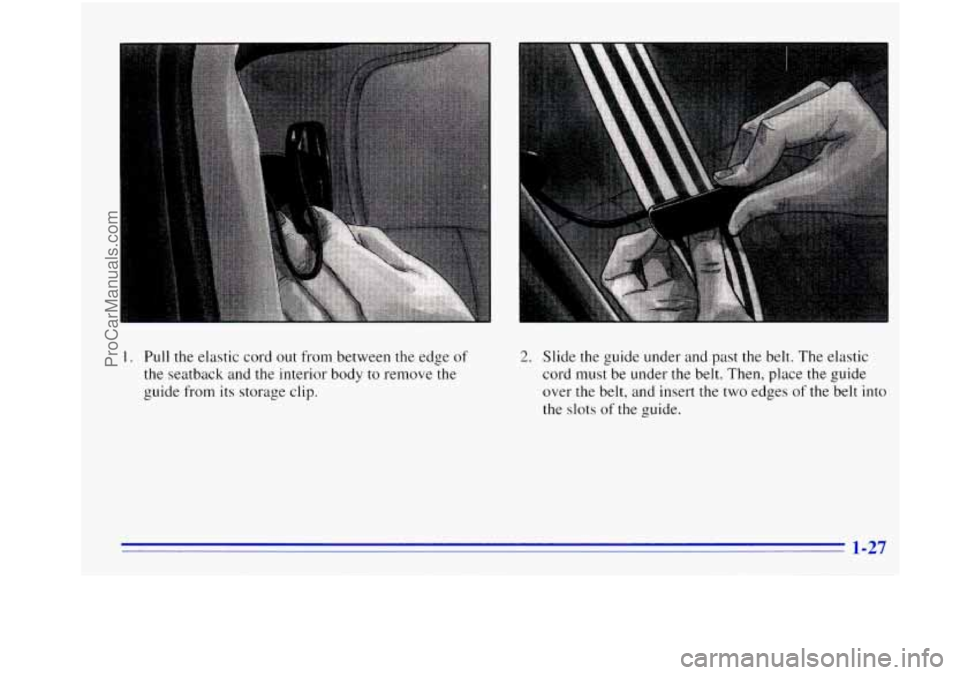
. Pull the elastic cord out from between the edge of
the seatback and the interior body to remove the
guide from its storage clip.
2. Slide the guide under and past the belt. The elastic
cord must be under the belt. Then, place the guide
over the belt, and insert the two edges
of the belt into
the slots of the guide.
1-27
ProCarManuals.com
Page 36 of 340
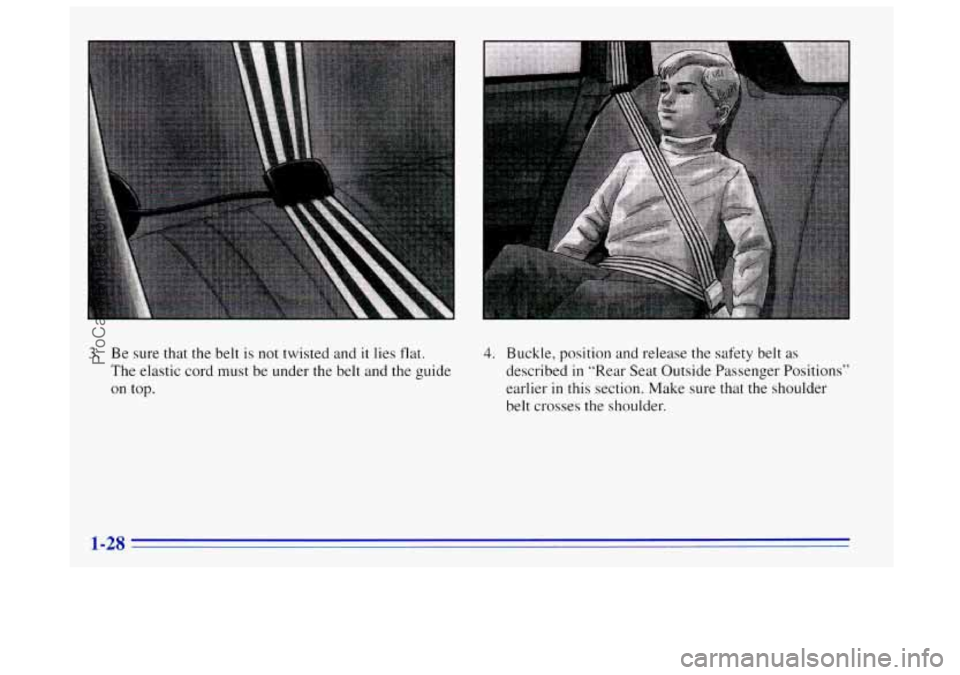
3. Be sure that the belt is not twisted and it lies flat.
The elastic cord must be under the belt and the guide
on top.
-
4. Buckle, position and release the safety belt as
described
in “Rear Seat Outside Passenger Positions”
earlier
in this section. Make sure that the shoulder
belt crosses the shoulder.
1-28
ProCarManuals.com
Page 37 of 340
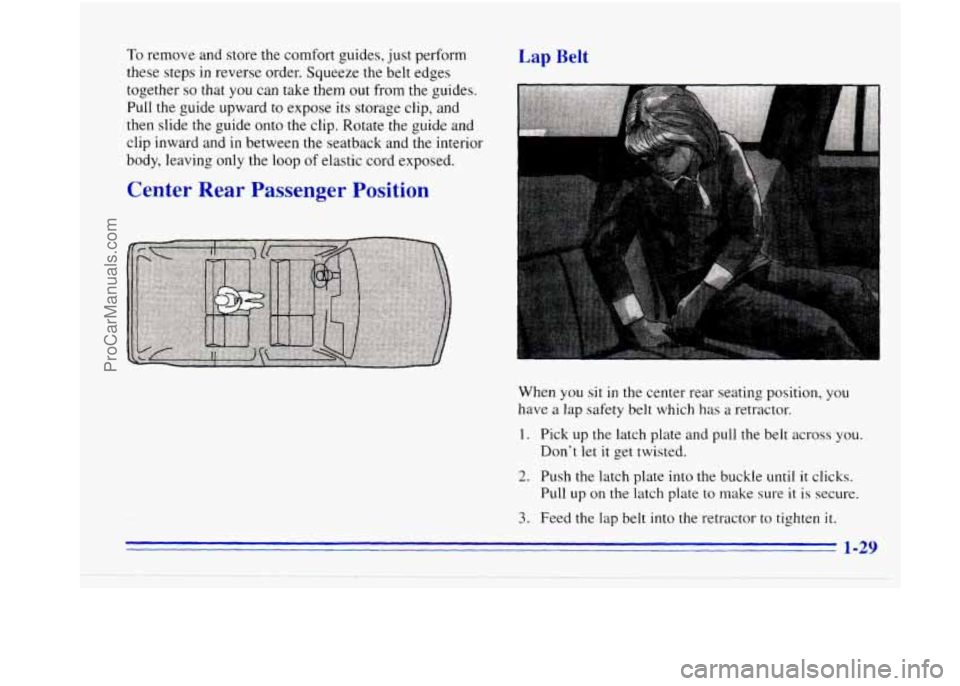
To remove and store the comfort guides, just perform
these steps
in reverse order. Squeeze the belt edges
together
so that you can take them out from the guides.
Pull the guide upward to expose its storage clip, and
then slide the guide onto the clip. Rotate the guide and
clip inward and in between the seatback and the interior
body, leaving only the loop
of elastic cord exposed.
Lap Belt
Center Rear Passenger Position
When you sit in the center rear seating position, you
have
a lap safety belt which has a retractor.
1. Pick up the latch plate and pull the belt across you.
2. Push the latch plate into the buckle until it clicks.
Don’t
let it get twisted.
Pull up
on the latch plate to make sure it is secure.
3. Feed the lap belt into the retractor to tighten it.
1-29
ProCarManuals.com
Page 38 of 340
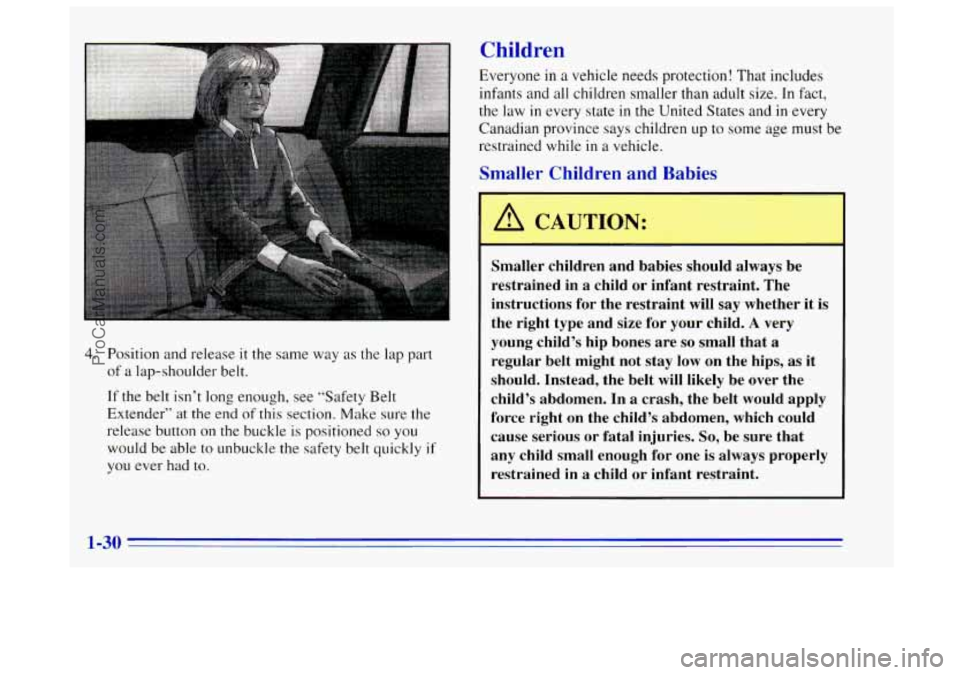
Children
4. Position and release it the same way as the lap part
of a lap-shoulder belt.
If the belt isn’t long enough, see “Safety Belt
Extender” at the end
of this section. Make sure the
release button
on the buckle is positioned so you
would be able to unbuckle the safety belt quickly
if
you eves had to. Everyone
in
a vehicle needs protection! That includes
infants and all children smaller than adult size. In fact,
the law
in every state in the United States and in every
Canadian province says children up to some age must be
restrained while in a vehicle.
Smaller Children and Babies
A CAUTION:
Smaller children and babies should always be
restrained in a child or infant restraint. The
instructions for the restraint will say whether it is
the right type and size for your child.
A very
young child’s hip bones are
so small that a
regular belt might not stay low on the hips, as it
should. Instead, the belt will likely be over the
child’s abdomen. In a crash, the belt would apply
force right
on the child’s abdomen, which could
cause serious or fatal injuries.
So, be sure that
any child small enough for one
is always properly
restrained in a child or infant restraint.
1-30
ProCarManuals.com
Page 40 of 340
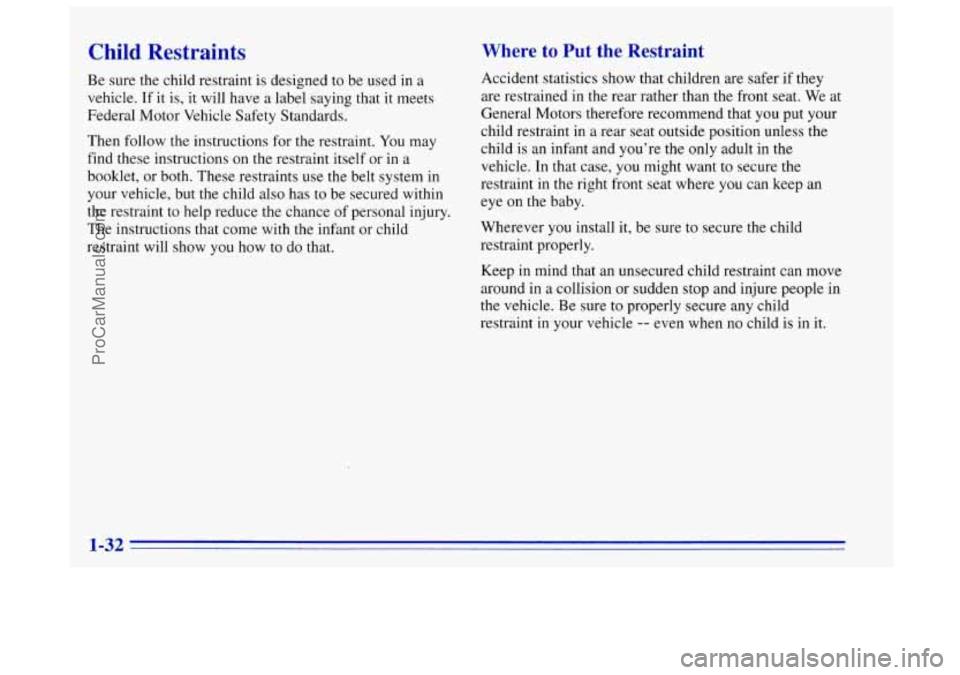
Child Restraints
Be sure the child restraint is designed to be used in a
vehicle.
If it is, it will have a label saying that it meets
Federal Motor Vehicle Safety Standards.
Then follow the instructions for the restraint. You may
find these instructions on
the restraint itself or in a
booklet, or both. These restraints use
the belt system in
your vehicle, but the child also has to be secured within
the restraint to help reduce the chance of personal injury.
The instructions that come with the infant or child
restraint will show you how to do that.
Where to Put the Restraint
Accident statistics show that children are safer if they
are restrained
in the rear rather than the front seat. We at
General Motors therefore recommend that you put your
child restraint in a rear seat outside position unless the
child is an infant and you’re the only adult in the
vehicle.
In that case, you might want to secure the
restraint in the right front seat where you can keep an
eye on
the baby.
Wherever
you install it, be sure to secure the child
restraint properly.
Keep
in mind that an unsecured child restraint can move
around in a collision or sudden stop and injure people in
the vehicle. Be sure
to properly secure any child
restraint in your vehicle
-- even when no child is in it.
ProCarManuals.com
Page 42 of 340
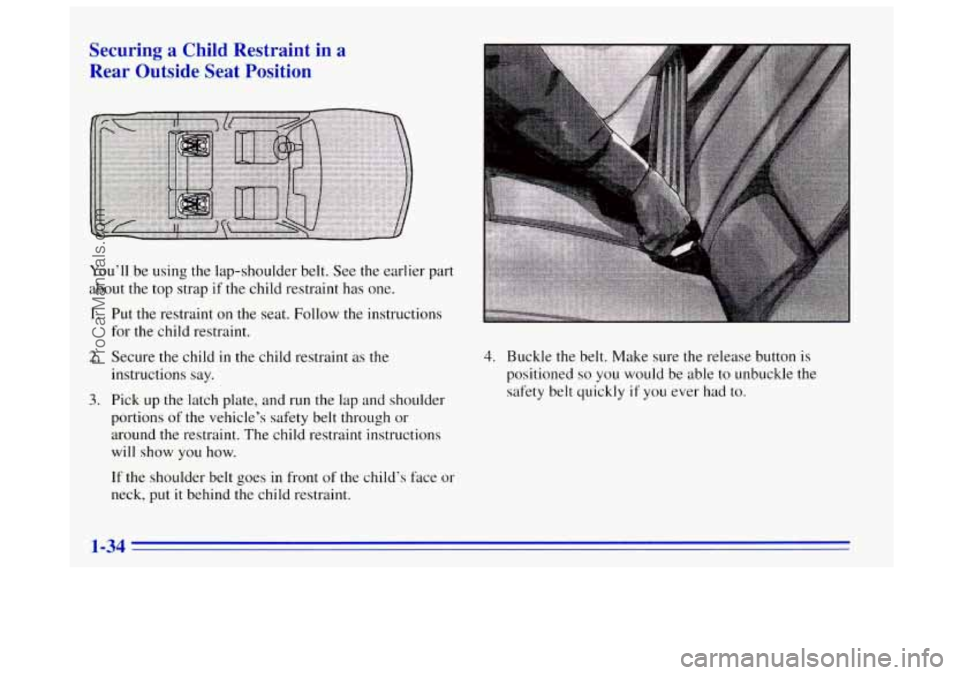
Securing a Child Restraint in a
Rear Outside Seat Position
You’ll be using the lap-shoulder belt. See the earlier part
about the top strap
if the child restraint has one.
1.
2.
3.
Put the restraint on the seat. Follow the instructions
for the child restraint.
Secure
the child in the child restraint as the
instructions say.
Pick up the latch plate, and run the lap and shoulder
portions
of the vehicle’s safety belt through or
around the restraint. The child restraint instructions
will show you how.
If the shoulder belt goes in front of the child’s fixe or
neck, put it behind the child restraint.
4. Buckle the belt. Make sure the release button is
positioned
so you would be able to unbuckle the
safety belt quickly
if you ever had to.
ProCarManuals.com
Page 43 of 340
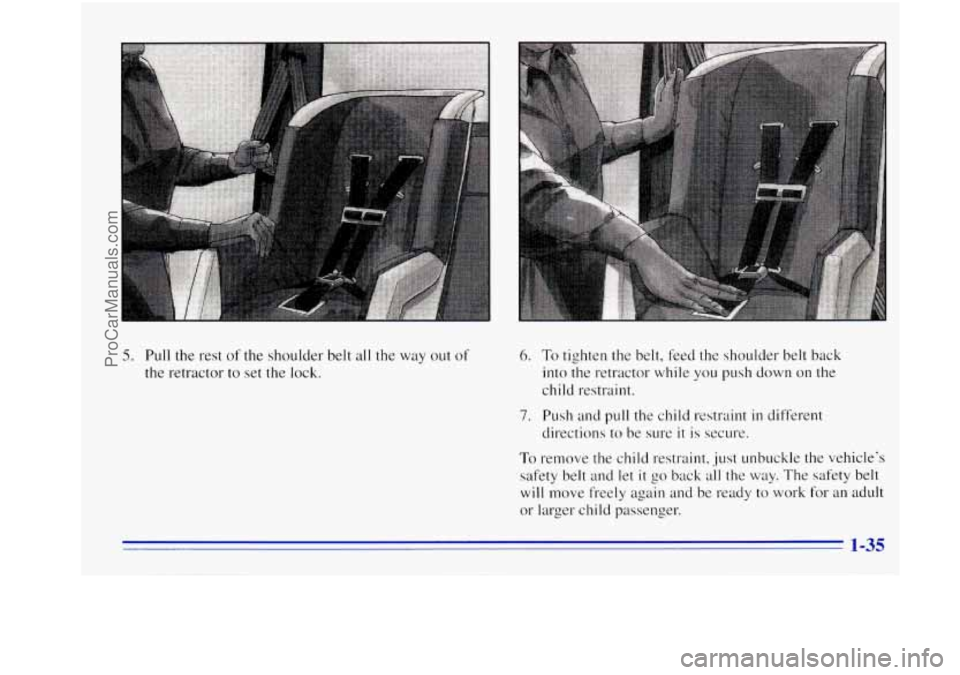
5. Pull the rest of the shoulder belt all the way out of
the retractor to set the lock.
6. To tighten the belt, feed the shoulder belt back
into the retractor while you push down on the
child restraint.
7. Push and pull the child restraint in different
directions to be sure
it is secure.
To remove the child restraint, just unbuckle the vehicle's
safety belt and let
it go back a11 the way. The safety belt
will move freely again and be ready to work for
an adult
or larger child passenger.
ProCarManuals.com